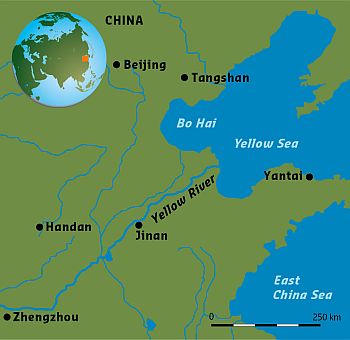China, Yellow River Wing
The Yellow River Delta (YRD) Wing of the Delta Alliance was officially established in October 2015, with Beijing Normal University (BNU) acting as the coordinating agency, and participating organizations comprise Yellow River Delta National Natural Reserve (YRDNNR) Administration Bureau, National Bird Banding Center of China and Beijing Forestry University. Prof. Dongdong Shao from BNU is currently serving the Wing Coordinator.
Yellow River Delta

The Yellow River is the sixth longest river in the world and the second longest river in China. As a result of frequent avulsion of the river course, the Yellow River Delta (YRD) has experienced dramatic changes in the past two thousand years. The present delta is located in the northeast of Shandong Province. It covers a total area of 18000 km2 with a population of 5.2 million people. The YRD is rich in natural resources, with the second largest oil field of China (the Shengli Oil Field) situated in the delta. At the same time, the YRD contains important wetland ecosystem, which is the habitat for numerous species, including millions of migrating birds of which many are under protection.
>> Read more
Coordinator
Dongdong Shao, School of Environment, Beijing Normal University, China - ddshao@bnu.edu.cn
>> Read more China Yellow River Wing network
Back ground information, news articles and videos.
|
Title |
Summary | Contact | ||
| China From Above: Yellow River Delta national natural reserve | This video shows the effectiveness of efforts to protect ecological diversity, restore wetlands, and promote harmonious coexistence between man and nature in the Yellow River Delta National Nature Reserve in Shandong Province, China. https://www.youtube.com/watch?v=4K1YtRF2hK8 |
New China TV | ||
| Migrating swans settle down in Yellow River wetlands | After the Yellow River Delta national natural reserve in Shandong province of China has making efforts to protect ecological diversity, over two thousand of migrating wild swans settle down in Yellow River wetland to escape the battle of the cold weather. https://www.youtube.com/watch?v=OuNSR9x2-Yk |
China Global Television Network (CGTN) | ||
|
Yellow River delta faces new challenges |
Steps taken to battle encroachment by sea caused by reduced flow, drop in silt: |
China Daily, Yang Li. | ||
| Watch China’s Coastline Dramatically Transform Over 35 Years | The Yellow River carries 1.6 billion tons of silt per year, when the Yellow River flows through the Loess Plateau. All the silt gets deposited at the river estuary where the Yellow River meets Bohai Sea caused the coastal erosion and delta area has changed. Agriculture and fish farming practices have caused the subsidence. Lowering the land surface makes more exposed to storm surges from the hurricanes and tsunamis. https://www.citylab.com/environment/2016/03/china-yellow-river-delta-erosion-transform-mapbox-1979/472977/ |
Tanvi Misra, CITYLAB | ||
|
Through Flood and Drought: Reconstructing the Yellow River
|
Using tree ring records fills the gaps in the historical information and provides insights into the natural flow of the Yellow River in China. This tree ring records could help to formulate water policies and management in the coming years. https://eos.org/research-spotlights/through-flood-and-drought-reconstructing-the-yellow-river |
Aaron Sidder, Earth& Space Science News | ||
| Deciphering Human Contributions to Yellow River Flow Reductions and Downstream Drying Using Centuries‐Long Tree Ring Records | In recently decades, the reductions of the Yellow River flow have considerable impacts on China’s economy and water policy. This study uses tree rings to reconstruct long-term Yellow River flow. Tree rings can assess the variability of the natural flow and detect the human contributions to the currently flow reductions of the Yellow River. With the three rings, the contributions of the human interventions and climate change to flow reduction are quantified. The results indicated that flow reduction is caused by human interventions instead of climate change since the late 1960s. Based on the basin- wide tree ring network, the Yellow River flow for the past 1,200 years are reconstructed. https://agupubs-onlinelibrary-wiley-com.ezproxy.library.wur.nl/doi/full/10.1029/2018GL081090 |
Jinbao Li Department of Geography, University of Hong Kong, Hong Kong jinbao@hku.hk | ||
| Combined Effects of Unsteady River Discharges and Wave Conditions on River Mouth Bar Morphodynamics | With the increasing variability of continuous climate change and human interventions, Delft3D- SWAN is used to assess the combined effects on mouth bar formation. The results of this study have important implications for water and sediment management strategies, such as water diversion, dam regulation, and prevention of the coastal erosion. https://repository.tudelft.nl/islandora/object/uuid:46ef3f74-0cf8-4637-a215-f09084439cef?collection=research |
Dongdong Shao, ddshao@bnu.edu.cn | ||
| Impact of Large-scale Reclamation on Coastal Wetlands and Implications for Ecological Restoration, Compensation, and Sustainable Exploitation Framework | This study analyzed the multiple impacts of coastal reclamation to biological structures, process and function. A large-scale coastal reclamation model was explored through research on the distribution of coastal wetlands and the structure of coastal biodiversity. Two categories with three levels of eco-compensation are formulated to promote the national strategic demand in eco-compensation. In this study, the balance between economic benefits and ecological loss are achieved. http://www.bulletin.cas.cn/zgkxyyk/ch/reader/view_abstract.aspx?file_no=20170413&flag=1 |
Baoshan Cui cuibs@bnu.edu.cn | ||
| China’s coastal Wetlands: reclamation impacts and ecological restoration | Due to the rapid economic development and population growth, coastal wetlands have considerable adopted to the land reclamation activities to meet the increasing land demands. In this study, the connections of land reclamation activities and economic development, damaged components of the coastal wetlands, problems and solutions of restoration are discussed. The results illustrated that“economy-reclamation-wetland degradation” should be imposed on land reclamation and formulated the reasonable policies based on the scientific research. |
Baoshan Cui cuibs@bnu.edu.cn |
News and activities
International workshop and expedition held on Yellow River delta coastal wetland protection and restoration
The international workshop and expedition on Yellow River delta coastal wetland protection and restoration was held on July 3 until 20, which brought international experts from China, the Netherlands and Italy to share knowledge on coastal wetland protection and restoration under intensified climate change and human impacts. Read a detailed summary of this event.
>> Read more ![]()
Delta Alliance Secretary / Yellow River Wing coordinator, Thursday 12 September 2019
National Basic Research Program of China
A National Basic Research Program of China (also known as the 973 Program) funded project ‘Impact Mechanism of Land Reclamation on Mega-Delta Wetland and Its Eco-restoration’ (2013-2017)
>> Read more
Publications
Natural enemies govern ecosystem resilience in the face of extreme droughts
In this study, we show that pressure from natural enemies regulates an ecosystem’s resilience to severe droughts. Field experiments revealed that in protected salt marshes experiencing a severe drought, plant-eating grazers eliminated drought-stressed vegetation that could otherwise survive and recover from the climate extreme, transforming once lush marshes into persistent salt barrens. Our study highlights that natural enemies can hasten an ecosystem’s resilience to drought to much lower levels than currently predicted, calling for integration into climate change predictions and conservation strategies.
Ecology Letters
>> Read more
Friday 1 February 2017
Coastal wetlands of China In this special issue, we synthesize current understanding of environmental changes and human impacts on China’ coastal wetlands, focusing on reclamation. For some of those impacts, new models and indices are developed or applied. We also outline key research areas that should be further studied for effective management of coastal wetlands and successful wetland restoration.
In this special issue, we synthesize current understanding of environmental changes and human impacts on China’ coastal wetlands, focusing on reclamation. For some of those impacts, new models and indices are developed or applied. We also outline key research areas that should be further studied for effective management of coastal wetlands and successful wetland restoration.
Special issue ‘Coastal Wetlands of China’ has been published in Wetlands, Editors are Prof. Baoshan Cui and some other key personnel involved in the 973 project.
Springer publishers
>> Read more
Tuesday 1 March 2016
Economic development and coastal ecosystem change in China
A multifaceted dataset was compiled to quantify coastal trends and examine the role of economic growth in China's coastal degradation since the 1950s. All 15 coastal human impacts examined increased over time, especially after the 1978 reforms. Economic growth has been proved the cause of accelerating human damage to China's coastal ecosystems. Without strict conservation efforts, continuing economic growth will further degrade China's coastal ecosystems.
Scientific Reports
>> Read more
Friday 8 August 2014